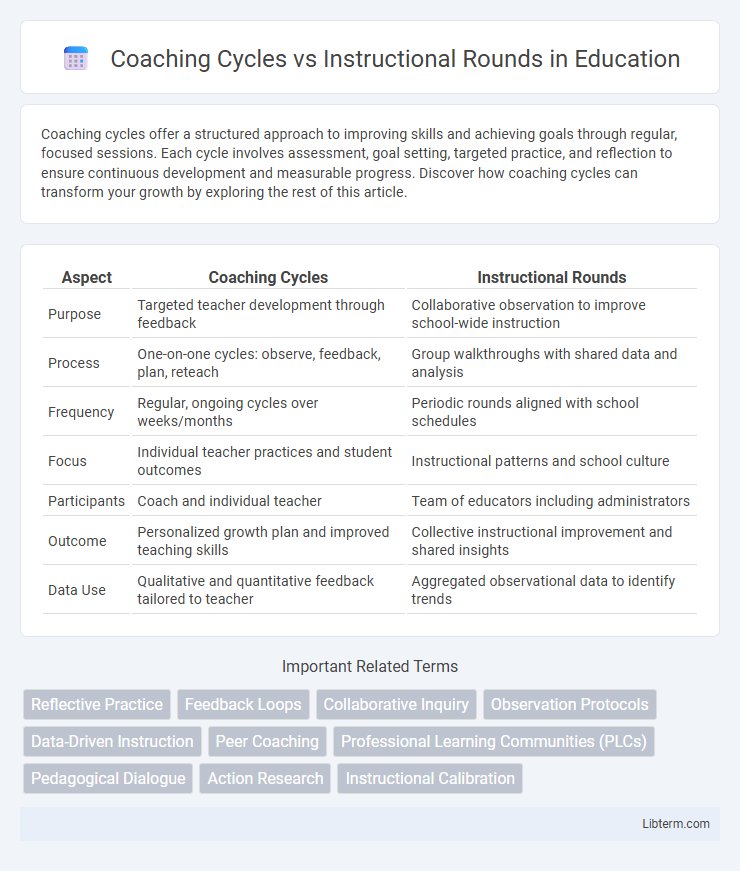Coaching cycles offer a structured approach to improving skills and achieving goals through regular, focused sessions. Each cycle involves assessment, goal setting, targeted practice, and reflection to ensure continuous development and measurable progress. Discover how coaching cycles can transform your growth by exploring the rest of this article.
Table of Comparison
| Aspect | Coaching Cycles | Instructional Rounds |
|---|---|---|
| Purpose | Targeted teacher development through feedback | Collaborative observation to improve school-wide instruction |
| Process | One-on-one cycles: observe, feedback, plan, reteach | Group walkthroughs with shared data and analysis |
| Frequency | Regular, ongoing cycles over weeks/months | Periodic rounds aligned with school schedules |
| Focus | Individual teacher practices and student outcomes | Instructional patterns and school culture |
| Participants | Coach and individual teacher | Team of educators including administrators |
| Outcome | Personalized growth plan and improved teaching skills | Collective instructional improvement and shared insights |
| Data Use | Qualitative and quantitative feedback tailored to teacher | Aggregated observational data to identify trends |
Introduction to Coaching Cycles and Instructional Rounds
Coaching cycles involve a structured process where educators collaborate through observation, feedback, and reflection to enhance teaching practices and student outcomes. Instructional rounds consist of teams visiting classrooms to observe teaching and learning environments, gathering data to identify patterns and inform school-wide improvements. Both approaches prioritize professional development but differ in focus: coaching cycles center on individualized teacher growth, while instructional rounds emphasize collective analysis and systemic change.
Defining Coaching Cycles
Coaching cycles consist of structured, iterative phases including goal-setting, observation, feedback, and reflection designed to enhance teacher performance and student outcomes. These cycles emphasize personalized support by targeting specific instructional strategies and professional development needs within a fixed timeframe. Instructional rounds, by contrast, involve collaborative groups observing multiple classrooms to identify broader patterns in teaching practices and promote collective improvement across schools.
Understanding Instructional Rounds
Instructional rounds involve a collaborative process where educators observe classroom teaching to gather evidence on instructional practices, promoting shared learning and continuous improvement. This approach centers on identifying patterns in teaching and learning, allowing teams to collectively analyze instructional strategies and student engagement. Understanding instructional rounds requires recognizing their role in fostering a culture of reflective practice and data-driven decision-making within schools.
Key Differences Between Coaching Cycles and Instructional Rounds
Coaching cycles focus on individual teacher development through goal-setting, observation, feedback, and reflection over a defined time frame, aiming at personalized instructional improvement. Instructional rounds involve collaborative peer observations where educators collectively identify best practices and systemic instructional issues within a school to promote shared learning. The primary difference lies in coaching cycles being personalized and iterative for individual growth, whereas instructional rounds emphasize collective analysis and school-wide instructional enhancement.
Goals and Objectives of Each Method
Coaching Cycles aim to enhance teacher practices through personalized, goal-oriented sessions that focus on continuous improvement and student learning outcomes. Instructional Rounds target school-wide instructional quality by enabling educators to collaboratively observe, analyze, and discuss teaching practices across classrooms. Both methods emphasize professional growth, with Coaching Cycles centering on individual teacher development while Instructional Rounds promote collective inquiry and shared instructional goals.
Structure and Process Comparison
Coaching cycles involve a structured, iterative process with defined stages including goal setting, observation, feedback, and reflection designed to support individual teacher growth. Instructional rounds focus on collaborative group observations where educators visit classrooms to collect data on teaching practices and student learning, followed by group discussions to identify patterns and improvement strategies. While coaching cycles emphasize personalized, continuous improvement through a coach-teacher partnership, instructional rounds prioritize collective inquiry and shared professional learning within a school community.
Impact on Teacher Professional Development
Coaching Cycles provide personalized, ongoing support through goal-setting, observation, and feedback, enhancing teachers' instructional strategies and boosting student outcomes. Instructional Rounds offer collaborative, data-driven observations where educators identify best practices and common challenges, fostering a culture of continuous improvement. Both approaches strengthen teacher professional development by promoting reflective practice, but Coaching Cycles emphasize individualized growth while Instructional Rounds focus on collective learning and shared expertise.
Benefits and Challenges of Coaching Cycles
Coaching Cycles promote personalized, goal-oriented professional development by enabling educators to reflect, receive feedback, and apply targeted strategies, which enhances instructional practices and student outcomes. Challenges include time constraints, the need for skilled coaches, and possible resistance to sustained collaboration or feedback. This method fosters continuous growth but requires commitment to scheduling and trust-building for maximum effectiveness.
Advantages and Limitations of Instructional Rounds
Instructional rounds offer the advantage of fostering collaborative teacher learning through direct classroom observations and collective data analysis, leading to targeted instructional improvements. Limitations include the time-intensive nature of organizing and conducting rounds, potential discomfort among teachers being observed, and the risk of feedback being too generic if not properly facilitated. Despite these challenges, instructional rounds promote a culture of continuous improvement by emphasizing evidence-based practices and peer accountability.
Choosing the Right Approach for Your School
Selecting between coaching cycles and instructional rounds depends on your school's goals, staff needs, and culture. Coaching cycles offer personalized, goal-oriented support through ongoing collaboration between coaches and teachers, enhancing instructional practices over time. Instructional rounds provide a collective, observational process where educators analyze teaching strategies and student engagement to drive school-wide instructional improvements.
Coaching Cycles Infographic

 libterm.com
libterm.com